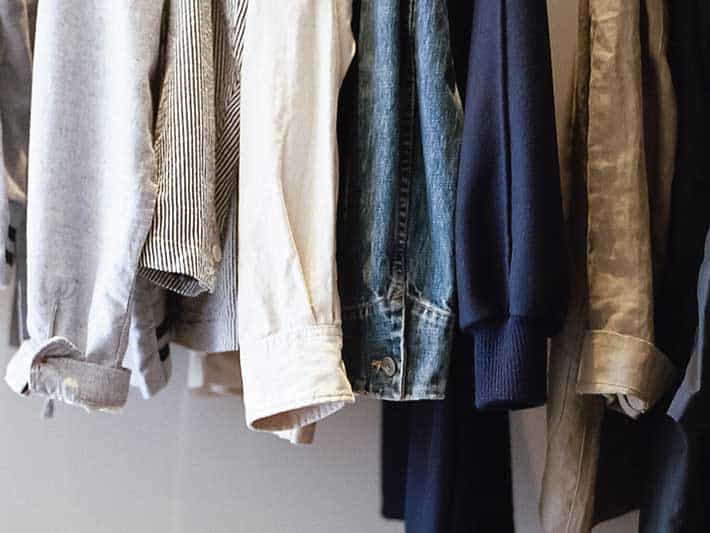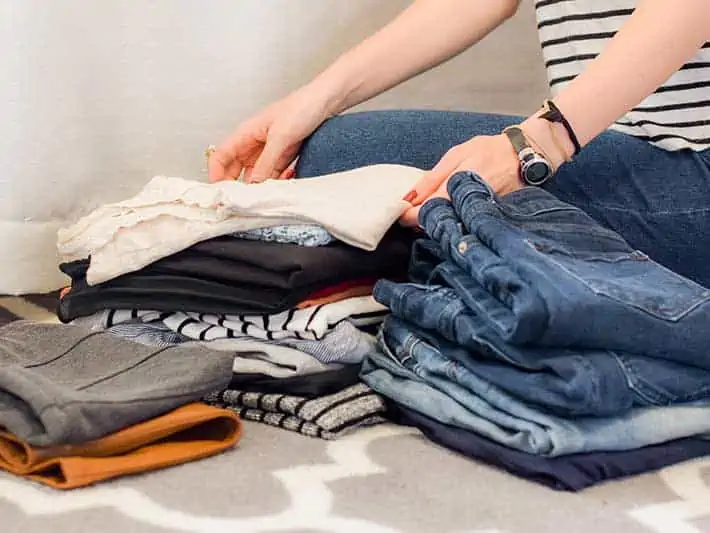How to Minimize Your Wardrobe - Declutter Your Closet & Save Money
Clothing and accessories are significant contributors to clutter. People hoard clothing they no longer wear for various reasons. A report by WRAP says that consumers in the UK have about £30 billion worth of clothes they have not worn for the past year5. By learning how to minimize your wardrobe, you can manage your space better and rid yourself of the mental and physical clutter that comes with having too much stuff.
The Problem of Owning Too Much Stuff
Every day, people buy more clothing and fashion items that they simply do not need. As reported by Forbes, the average woman in England has about 22 unworn items hanging in her closet. Assuming each clothing item is worth an average retail/resale price of £50, that would amount to £1,100 sitting in the closet.
Unfortunately, the most likely destination for such clothing is the dumpster. Lord Taylor, who served as a Minister for Environment in Defra, UK, says that the estimated 430,000 tonnes of clothing that end up in the landfill each year could have been commercially valuable.
The global consumer fashion expenditure amounts to a combined GDP of the 126 most impoverished countries globally. The total amount is larger than the Italian economy. Retailers sold over 107 billion clothing items and 14.5 billion pairs of shoes in 2016 alone.
Experts predict a 13% increase in demand by 20213. This statistic may appear favorable for the fashion industry, but it is not. More clothing might equal more pollution when considering the prevalent system of linear usage and fast fashion.
Keeping Our Clothes Clean
Keeping unused clothes clean requires as much effort as maintaining the clothes we wear regularly. When someone in the UK uses a washing machine to dry clothes, they contribute to about 10% of total carbon emissions from vehicles in the UK6.
Maintaining so many clothes we don't use is easier said than done. Many people already struggle to care for the clothes and accessories they regularly wear correctly.
The planet is battling textile waste problems, and hoarded clothing pieces will eventually join those in landfills. Long periods of no use and improper closet storage can cause them to develop mold, stains, cracks, tears, and so on. As such, this makes the items lose value way before the due date.
When Thinking How to Minimize Your Wardrobe - Start with Understanding How a Cluttered Wardrobe Happens

The strain of dealing with clutter is both emotionally and physically tasking. A survey carried out by the Association of Professional Organizers shows that 54% of Americans find surrounding clutter overwhelming.
The survey also reveals that 78% of them find decluttering daunting. Another study discovered that many mothers who work as primary home keepers suffer from elevated stress hormone levels from managing the family's clutter. It would be much better to avoid the traps of accumulation than to try to control the clutter. Choosing to let go by decluttering and minimizing your closet can help you save more time and money.
Decluttering your wardrobe also ensures that your environment is clean and healthy. Unwanted items may go to charity, online thrift stores, friends, and family, while others will fall in the trash. A minimalist and organized closet makes it easy to get rid of insects and rodents that would generally live unnoticed under an untidy heap of clothes.
Low-Cost Clothing
Frequently, people purchase clothing, shoes, or bags because they got a good deal on them. They usually believe it wouldn't hurt to buy since it comes at a low price. A good number of them will discover that it doesn't match their outfits or fit into their style once they get home. They will likely stash the item in the closet, hoping that it will come in handy someday but may end up forgotten. Minimizing your wardrobe will ensure that you do not spend money on items just for the thrill and prioritize long-lasting quality items.
Whether you buy items cheaply, an individual may find it hard to part with them when considering the price. They can also slip into closet clutter when they buy trending items just to fit in, regardless of whether they like it or not.
In the world of fast fashion, trends change quickly without any prior notice. Most consumers will abandon these trendy pieces once they go out of style. Taking a minimalistic approach will require you to put an end to splurging on such items in favor of a few pieces you love wearing.
Buying Clothes That Aren't Quite right
Sometimes a person may buy fashion pieces that designers claim as a staple or must-have only to realize that the item is uncomfortable or doesn't fit their body type. Getting a staple item is a practical thing to do, but without care, it can lead to closet clutter if care.
Other times, consumers can hold on to clothing and accessories because of technical damages. They may have bought the items in excellent condition, only to discover faults before or after the first use. These faults seem unfixable, at least by anyone except the manufacturer, to whom they don't have access.
Sometimes clothes shrink, develop color splotches, earrings break, and a bag's clasp gets damaged. These faults may develop in integral parts of the design, rendering them useless for the intended purposes.
We can easily find things ready for repair in most people's closets. We may keep these items we bought years ago, hoping to fix them, but will later find them impossible or expensive to fix. While it is excellent to repair clothing and jewelry rather than throwing them away, making a habit of procrastinating the repairs contributes to clutter buildup in our closets.
Clothes That No Longer Fit
Another reason clothing may clutter the wardrobe includes a change in an individual's body size.
As humans, we experience health challenges, hormonal changes, or intentional weight changes that cause us to lose or add weight. When a person's body weight changes, they're bound to have a lot of clothes that don't fit anymore hanging in their wardrobes.
If the weight change is intentional, they might find it easier to get rid of the clothes that no longer fit. In a case where it is unintentional, they will find it hard to let go of those clothes often because they are hoping to get back to their former size, which may leave those clothes in the closet for quite some time.
Special Occasions
It is common for people to buy or make clothing for special occasions. These clothes are usually elaborate and tailored for a single event, sometimes events that occurred years ago. Although such clothing may be of high value, they lack versatility since we can typically only wear them occasionally. Clothes for special occasions generally are expensive to purchase. Therefore, people keep them in the back of the closet for monetary and sentimental value.
Time-Saving
Some people might also believe that having a lot of clothes means they don't have to do laundry often. So, they buy enough clothes that can last for weeks without having to wash them.
Having too much clothing, shoes, bags, and other accessory pieces stashed away in the closet demand extra effort for their maintenance. Many people may not have the required time and energy to organize the clutter that often results from too many clothes. When you minimize your closet, it will take away the problem of clutter once and for all.
A minimized wardrobe is one that is easy to organize and manage. Getting dressed will be easier when you know exactly the pieces you have without digging through a mountain of clothes.
Where to Start Minimizing Your Wardrobe?

According to Suzie Faux, there are many ways to minimize your wardrobe, but a capsule wardrobe is the best way to go. Capsule wardrobes contain only a few essential clothes and accessories that are timeless, complementary, and durable.
The term was first used in the 1970s by Faux, but Donna Karan made it famous in 1985. Karan created the first capsule collection, "Seven Easy Pieces," in the same year.
Find yourself asking, "what to do with all my clothes?." Read on:
The Marie Kondo Method
Marie Kondo, a Japanese organizing specialist, invented the KonMari tidying method. The trademark method advocates tidying and organizing items by category instead of location. As such, you can decide to tackle clothing for a minimalist wardrobe or any other clutter in every room of your house.
The method is one that is not only useful for minimizing your wardrobe; it makes tidying up the entire house easier. You can easily apply the KonMari method for organizing your closet space by choosing to tackle one specific clothing item at a time.
Kondo advises that it's better to keep things with great sentimental and functional value, such as t-shirts and yoga pants. In the same vein, dispose of/send all items that you no longer find useful or offer comfort to the thrift store. The famous "Decluttering Bible" was written by Kondo and contained several valuable tips for minimizing wardrobe and maximizing space.
Minimalist fashion is said to be increasing in appeal to millennials. Minimalism could be by the number of clothing items, exactly like the capsule wardrobe. It could also mean choosing a design with clean shapes, and versatile colors, with a focus on the quality of the material1.
A minimalistic approach to wardrobe setup is being pioneered by scientific and design research into transformable garments. Transforming clothes could change aesthetics like color and design.
We believe that creating eco-friendly clothing that consumers can wear in different ways will satisfy a wide range of needs4. Apart from preventing waste, it will also reduce the strain of shopping and an overflowing wardrobe for consumers drastically2.
How to Practice Mindful Shopping to Prevent a Relapse
One should be intentional whenever attempting to minimize your wardrobe. Each individual has to consider some factors as they make shopping decisions. It would amount to waste and clutter if a student stocks up on executive workwear just because they look appealing. You won't need the same clothing as someone who works in a bank if you wear a uniform to work every day. Similarly, consider seasonal items based on your weather and are most likely to experience them. It is essential to choose clothing to fit your current lifestyle and work.
Quality always trumps quantity. Therefore, it is advisable to opt for high-quality garments with a unique designs. Buying one piece of high-quality clothing may be more expensive than four cheaper pieces, but the durability each one offers will make it worthwhile.
A high-quality item has less probability of developing a technical fault. Before purchasing any clothing item, check the composition of the material on its label and find out if it is susceptible to pilling, fading, or shrinking.
Versatility
If you are not an expert in ascertaining garment quality, you could do a little research before purchasing expensive pieces. Another critical consideration is versatility.
In a minimal wardrobe, each item should be able to serve multiple functions. An example is a camisole that could serve as workwear when combined with a pantsuit and also pair nicely with a blazer and skirt for attending church. You can also pair this camisole with a mini-skirt or skinny jeans complete with ankle boots and wear it to the club, party, or a date.
We should view versatility through the lens of color, functionality, and design details. You can pair versatile clothing with other accessories to dress it up or down. Avoid items with colors that don't match most of the ones you already have.
When minimizing your wardrobe, consider coloring (based on personal preferences). Having fewer clothes means you can easily keep a mental track of the colors you have and use that as a guide when shopping for new clothes or accessories.
You can then quickly decide if the color of an available item would match the content of your wardrobe or otherwise. No matter how stylish, one fashion item would sit in your hanger closet for a long time if its color doesn't match the accessories you already own.
Ways to Prevent a Relapse
Mending broken items on time will significantly help fix the problem of clutter. It's ideal to invest time, effort, and money into repairing damaged clothing instead of getting a cheap temporary replacement.
Special occasions such as weddings, festivals, or photoshoots require unique clothing. These events give people a chance to express themselves through clothing differently. Exploring short or long-term clothing rental options can eliminate the need to get a new outfit for each special occasion.
You can sell, rent out or exchange some attires during Halloween or photoshoot sessions and earn some money, which means that they don't get to take up space in your wardrobe for years without use.
Minimizing your wardrobe will be unsuccessful if you keep unwanted clothing around after decluttering. Such clothing will quickly find its way back into your closet if they are still accessible. It's imperative to adopt ethical disposal to tackle the possibility of a relapse into clutter.
Other options include thrifting, upcycling clothes, donating to charity, or someone who would find a better use for them. You can recycle the remainder of your old clothes even if they are no longer useful.
Conclusion
Minimizing your wardrobe is beneficial to you and the environment. It would help you develop a more practical and disciplined attitude towards clothing consumption. Not only will you be saving money, but you will also protect the planet.
| 1 | Karg, C., (2015, p. 2 & 6). New Fashion Minimalism In An Affluent Society: A Paradigm Shift? |
| 2 | Koo, H. (2012, p. ii & 2). Design Functions In Transformable Garments For Sustainability |
| 3 | CO DATA: Volume And Consumption: How Much Does The World Buy? |
| 4 | Hatef, Mazi & Shaharuddin, Siti. (2019). Adopting C2CAD Model To Eco Capsule Wardrobe Design. International Journal of Scientific & Technology Research. 8. 1224-1233. |
| 5 | WRAP, Valuing Our Clothes: the cost of UK Fashion, July 2017. |
| 6 | WRAP, Valuing Our Clothes: the cost of UK Fashion, July 2017. |
Jen’s a passionate environmentalist and sustainability expert. With a science degree from Babcock University Jen loves applying her research skills to craft editorial that connects with our global changemaker and readership audiences centered around topics including zero waste, sustainability, climate change, and biodiversity.
Elsewhere Jen’s interests include the role that future technology and data have in helping us solve some of the planet’s biggest challenges.

